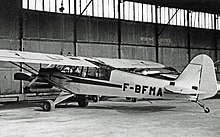
The Piper PA-23, named Apache and later Aztec, is a four- to six-seat twin-engined light aircraft aimed at the general-aviation market. The United States Navy and military forces in other countries also used it in small numbers. Originally designed in the 1950s by the Stinson Aircraft Company, Piper Aircraft manufactured the Apache and a more powerful version, the Aztec, in the United States from the 1950s to the 1980s.

The Piper PA-14 Family Cruiser is an American-built small touring aircraft of the late 1940s.

The Piper PA-24 Comanche is an American four-seat or six-seat, low-wing, all-metal, light aircraft of semimonocoque construction with tricycle retractable landing gear. Piper Aircraft designed and developed the Comanche, which first flew on May 24, 1956. Together with the PA-30 and PA-39 Twin Comanches, it made up the core of the Piper Aircraft lineup until the production lines for both aircraft were destroyed in the 1972 Lock Haven flood.

The Piper J-3 Cub is an American light aircraft that was built between 1938 and 1947 by Piper Aircraft. The aircraft has a simple, lightweight design which gives it good low-speed handling properties and short-field performance. The Cub is Piper Aircraft's most-produced model, with nearly 20,000 built in the United States. Its simplicity, affordability and popularity invokes comparisons to the Ford Model T automobile.

The Cessna 120,140, and 140A, are single-engine, two-seat, conventional landing gear (tailwheel), light general aviation aircraft that were first produced in 1946, immediately following the end of World War II. Production ended in 1951, and was succeeded in 1959 by the Cessna 150, a similar two-seat trainer which introduced tricycle gear. Combined production of the 120, 140, and 140A was 7,664 units in five years.

The Piper PA-15 Vagabond and PA-17 Vagabond are both two-seat, high-wing, conventional gear light aircraft that were designed for personal use and for flight training and built by Piper Aircraft starting in 1948.
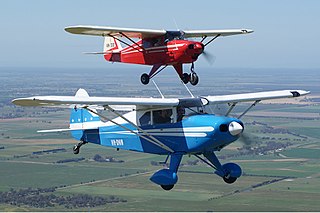
The PA-20 Pacer and PA-22 Tri-Pacer, Caribbean, and Colt are an American family of light strut-braced high-wing monoplane aircraft built by Piper Aircraft from 1949 to 1964.

The Piper PA-30 Twin Comanche is an American twin-engined cabin monoplane designed and built by Piper Aircraft. It was a twin-engined development of the PA-24 Comanche single-engined aircraft. A variant with counter-rotating propellers was designated the Piper PA-39 Twin Comanche C/R.

The Piper PA-34 Seneca is a twin-engined light aircraft, produced in the United States by Piper Aircraft. It has been in non-continuous production since 1971. The Seneca is primarily used for personal and business flying.

The Piper PA-18 Super Cub is a two-seat, single-engine monoplane. Introduced in 1949 by Piper Aircraft, it was developed from the Piper PA-11, and traces its lineage back through the J-3 to the Taylor E-2 Cub of the 1930s. In close to 40 years of production, over 10,000 were built. Super Cubs are commonly found in roles such as bush flying, banner towing and glider towing.
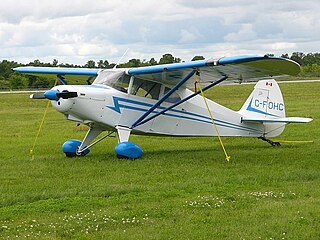
The Piper PA-16 Clipper is an extended fuselage model of the PA-15 Vagabond. Both models were designed in 1947 for the same reason – Piper Aircraft found itself in dire financial straits and needed to create new, competitive models using existing parts and tooling. The result was the Vagabond, essentially a side-by-side version of the tandem J-3 Cub credited with saving the company.

The Piper J-5 Cub Cruiser was a larger, more powerful version of the basic Piper J-3 Cub. It was designed just two years after the J-3 Cub, and differed by having a wider fuselage with the pilot sitting in the front seat and two passengers sitting in the rear seat. Equipped with a 75-hp Continental engine the plane's cruising speed was 75 mph. Though officially a three-seater, it would be more accurately described as a "two-and-a-half-seater", as two adults would find themselves quite cramped in the wider rear seat. The Cruiser sold for $1,798 when it was first designed.

The Piper PA-12 Super Cruiser is an American three-seat, high wing, single-engine conventional landing gear-equipped light aircraft that was produced by Piper Aircraft between 1946-48. The PA-12 was an upgraded and redesignated Piper J-5.

The Piper J-4 Cub Coupe is a two place side-by-side version of the Piper J-3 that was built between 1938 and 1942 by Piper Aircraft. It was Piper's first model with side-by-side seating; combined with docile low-speed handling, this made it a good trainer.

The Aeronca Model 7 Champion, commonly known as the "Champ", or "Airknocker", is a single-engine light airplane with a high wing, generally configured with fixed conventional landing gear and tandem seating for two occupants.
The Piper PA-8 Skycycle was a 1940s American single-seat light aircraft designed and built by Piper Aircraft at their Lock Haven, Pennsylvania plant. Towards the end of 1944 Piper announced a number of aircraft it intended to build after the war. One of these was the PWA-8. An aerodynamic test aircraft was built with the name Cub Cycle and it first flew on 27 August 1944 with a small two cylinder Franklin engine. The Franklin engine was replaced by a 37 hp (28 kW) Continental A-40-3 and the aircraft first flew with the Continental engine on 12 September 1944. The Skycycle was a fabric-covered mid-wing single-engined single-seat monoplane with a tailwheel landing gear. The fuselage was produced using a belly fuel tank as used on the F4U Corsair. The Cub Cycle was scrapped and a similar but new aircraft was built with the name Skycycle. The Skycycle first flew on 29 January 1945 using the same Continental engine as the Cub Cycle. The aircraft was further modified in 1945 with a 55 hp (41 kW) Lycoming O-145-A2 engine and designated the PA-8 Skycycle. No further examples were built.
The Piper PA-6 Sky Sedan was a 1940s American four-seat light aircraft designed and built in prototype form by Piper Aircraft at its Lock Haven, Pennsylvania, factory.
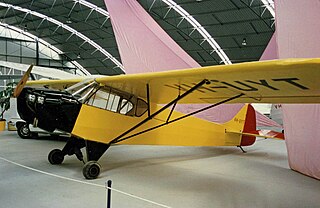
The Taylor J-2 Cub is an American two-seat light aircraft that was designed and built by the Taylor Aircraft Company. The company became the Piper Aircraft Company and the J-2 was first of a long line of related Piper Cub designs.
The Piper PA-29 Papoose was an American single-engined training monoplane designed by Piper, only one was built and the type did not enter production.
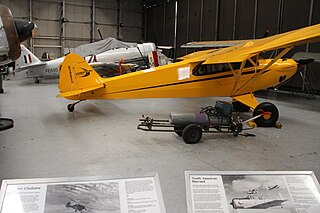
The Cub Crafters CC11-100 Sport Cub S2 is a high-wing, tandem-seat, conventional landing gear–equipped, tube-and-fabric light-sport aircraft built by Cub Crafters. The aircraft certified to ATSM standards for the FAA's Light Sport Category and is in production as of 2010. The S2 was introduced in 2007 as an improvement to the Sport Cub of 2005.



